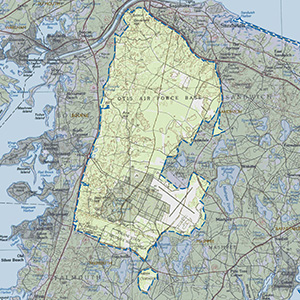Important Bird Area Sites in Massachusetts
Important Bird Area: Massachusetts Military Reservation
Site Summary
Nominated By
Peter Trimble
Size
22,000 acres
Towns and Counties
Bourne, Falmouth, Mashpee, Sandwich; Barnstable
Ownership
federal military, state, municipal, county jail
Major Habitats
18% pitch pine/scrub oak forest, 8.3% early successional shrubland, 6.8% cultural grassland, emergent freshwater wetland powerline, palustrine woodland swamp, shrub-scrub wetland, lake/pond, urban/suburban, migratory stopover site, scrub oak/shrub
Land Use
nature & wildlife conservation/land trust, hunting/fishing, quarry/gravel pit, etc., water supply, utility right-of-way, suburban/residential, urban/industrial/commercial, research, military, undeveloped
Serious Threats
succession (lack of active disturbance regime, e.g., fire)
Minor Threats
invasive, non-native plants, introduced animals, soil erosion/degradation
IBA Criteria
- Category 1: Sites important for long-term research and/or monitoring projects that contribute substantially to ornithology, bird conservation, and/or education.
- Category 2: Sites containing assemblages of species characteristic of a representative, rare, threatened, or unique habitat within the state or region.
- Category 4: Single-species Concentrations: The site regularly supports significant concentrations of a flocking species, but may not meet the thresholds above. The site should support a higher proportion of a species' statewide population (more than 1%, if known) than other similar sites.
- Category 5: Land Birds: The site is an important migratory stopover or seasonal concentration site for migratory land birds (e.g., warblers). Sites may also qualify on the basis of supporting exceptionally high densities of breeding species as shown from point counts or other surveys or if they represent "migrant traps" relative to surrounding areas. Strong consideration will be given to areas with consistently high overall species diversity..
Site Description
The Massachusetts Military Reservation (MMR) is about 22,000 acres and is used by the various branches of the military and other federal and state agencies. It is bordered on the north by the Sandwich moraine and on the west by the Buzzards Bay moraine. To the south and east of the moraines is a large, relatively flat, glacial outwash plain. Most of MMR is forested uplands dominated by pitch pine and a mixture of oaks. Large burn areas dominated by live scrub oak, numerous pine and oak snags, and switchgrass and Little Bluestem provide habitat for cavity-nesting birds. Wetlands and deep-water habitats are rare on the Reservation, comprising less than 1 percent of the total land area. Dirt roads and power lines pass through forested and burned areas, providing edge habitat. Surrounding the runways at Otis are grasslands, dominated by little bluestem. Bird surveys and other biological surveys have been conducted in all of these habitats.
The Crane Wildlife Management Area is south of the MMR and has similar habitat with similar species. For example, Grasshopper Sparrows, Eastern Towhees, and Brown Thrashers have nested here for years. This area has varied uses, which could negatively affect the success of nesting bird species. Since it is contiguous with the MMR, it should be considered as part of the Important Bird Area.
Current Conservation Status
The importance of the MMR as a relatively contiguous habitat for wildlife cannot be overstated when one considers both the magnitude of development on Cape Cod and the Islands and the generally small parcels remaining that might be protected. Many plant and animal species have a chance here due to the size of the reservation.
Ornithological Significance
Upland Sandpipers have used the southern portion of the MMR during the breeding season for many years. The species occurs in the grassy areas around the runways and in the cantonment area. In 2002 the cantonment and runways were surveyed once by a complete meander survey. At least nine different birds were counted. All of these sightings were in the fenced runway areas. Northern Harriers are seen throughout the year both in the impact area and in the southern portions around the runways and cantonment. In recent years, a few to as many as eight have been observed. These totals are estimated from many sightings made on almost a daily basis. In 2002 a minimum of five different individuals were counted. Vesper Sparrows have been found during the breeding season both in the range and cantonment areas. The Grasshopper Sparrow has been recorded as a breeding species every year in the cantonment area and near the runways. In 2001 there was a minimum of seven singing birds in the cantonment. In 2002 there were atleast eleven singing birds in the cantonment, and at least three singing birds were found along the runways.
Category 2 birds, listed below, were counted during point counts and meander surveys of grasslands conducted in 2001 and 2002. Woodland, shrubland, and grassland species found on power lines would be more numerous than these numbers indicate since they represent only a portion of these habitats on the MMR. Whip-poor-wills and other crepuscular or nocturnal species were not specifically surveyed for.
Other Flora or Fauna of Significance
Plants: Endangered- Broad Tinker's weed, Torrey's Beak rush; Threatened- Adder's Tongue Fern
Reptiles: Special Concern-Eastern Box Turtle
Dragonflies and Damselfilies: Threatened-Barrens Bluet; Special Concern-Comet Darner
Moths: Threatened-Barrens Daggermoth, Melsheimer's Sack Bearer, Barren's Buckmoth, Water-willow Stem Borer; Special Concern- Gerhard's Underwing, Coastal Heathland Cutworm, Straight Lined Mallow Moth, Pine Barrens Itame, Coastal Swamp Metarranthis, Pine Barrens Zale.
The Massachusetts Army National Guard Natural Resource Office is conducting Eastern Box Turtle research, bat surveys, odonate inventories, Whip-poor-will research, small mammal inventories, plant inventories, and fungus inventories. The Lloyd Center for the Environment has conducted inventories of Lepidoptera.
Data Sources
Breeding bird surveys, Land Condition Trend Analysis transects, point counts, meander surveys, and P. Trimble, personal observations.
Bird Observer article Volume 24, No. 4, 1996.




